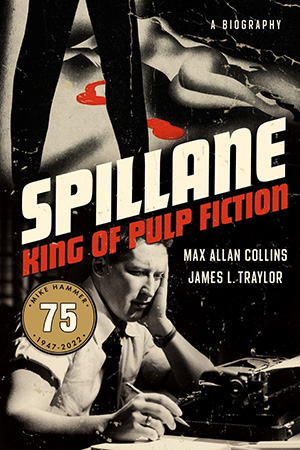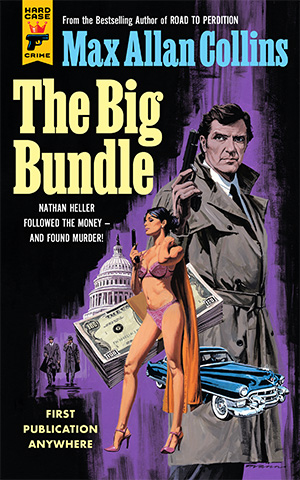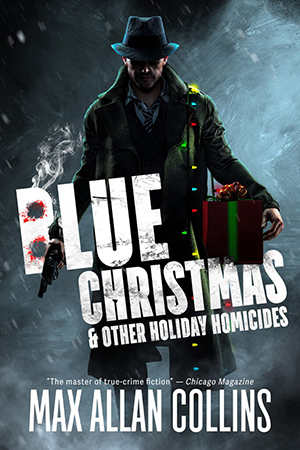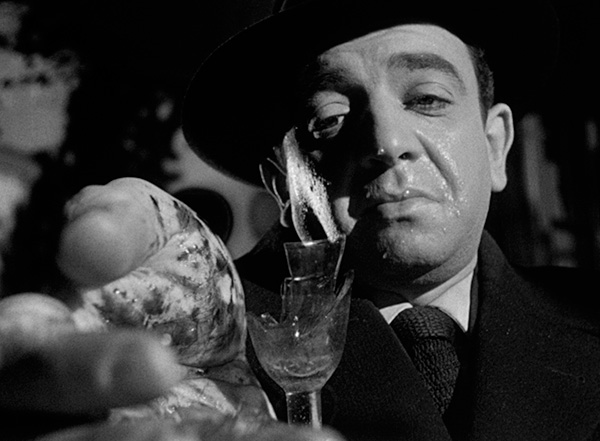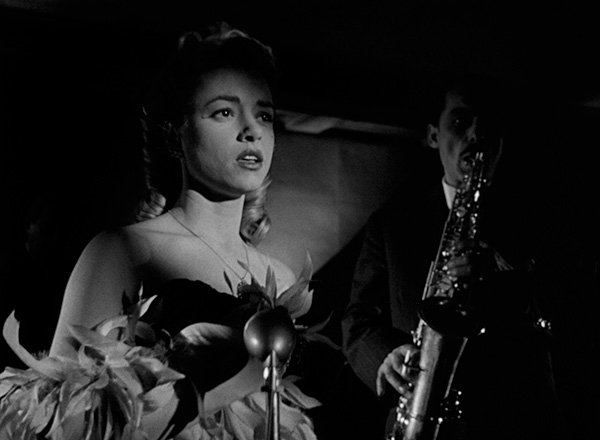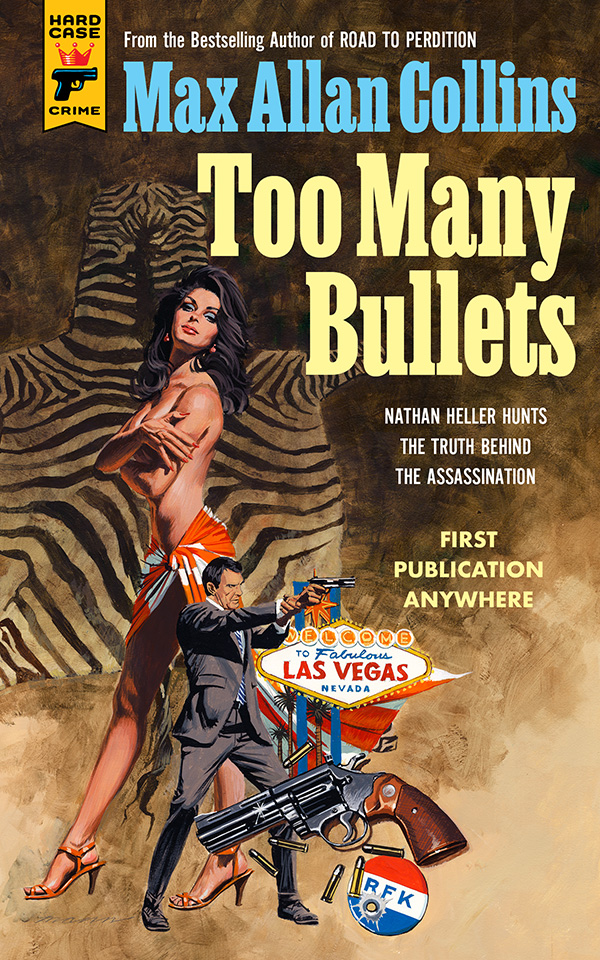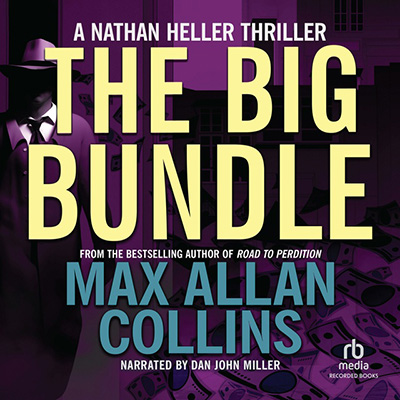I have been getting my stocking stuffed early (I am very happy to say) with good reviews for The Big Bundle and Spillane – King of Pulp Fiction.
You may recall that The Big Bundle received a starred review from Publisher’s Weekly and went on to being one of PW’s Books of the Week. Now here is PW’s starred review of Spillane – King of Pulp Fiction (due out the first week of February and can be pre-ordered now):
Max Allan Collins and James L. Traylor. Mysterious, $26.95 (384p) ISBN 978-1-61316-379-5
In 1947, Mickey Spillane (1918–2006) unleashed his hyperbolic private eye and WWII vet, Mike Hammer, on the world with I, the Jury, a revenge saga that featured a major infusion of sexual innuendo and unfettered violence that scandalized not only other mystery writers but also the publishing industry and beyond. In this illuminating biography, the first devoted to Spillane, MWA Grandmaster Collins (the Nathan Heller series), a late-life collaborator of Spillane’s, and critic Traylor provide incisive analysis of Spillane’s unique career. Employing exhaustive research and their access to Spillane’s personal archives, the authors move from Spillane’s precocious childhood to his time at comic book publisher Timely writing text fillers; his WWII service as a flight instructor; the epic breakthrough with the Signet/NAL paperback edition of I, the Jury; the superstar years of 1948–1953, when each Mike Hammer novel was reprinted in the millions; and his surprise conversion to the Jehovah’s Witness movement. Spillane’s growing appetite for acting and star-making turn in the 1970s as a TV pitchman for Miller Lite beer is recounted in colorful detail, while his long-delayed triumph in being named a Grand Master by his MWA peers in 1995 is quite affecting. The book concludes with several highly informative appendices, including Collins’s fascinating “Completing Mickey Spillane.” This definitive work is indispensable for any fan of the revolutionary Spillane and his two-fisted novels. Agent: Dominick Abel, Dominick Abel Literary. (Feb.)
Not to leave The Big Bundle out of the mix – available now on e-book and on audio and in hardcover next month – here’s a great write-up from that pro’s pro in prose (sorry!), James Reasoner.
Max Allan Collins’ Nathan Heller series began in 1983 with True Detective. (Almost 40 years ago? How is that possible?) True Detective is one of the best private detective novels I’ve ever read. Through 18 more novels and story collections since then, Collins has maintained an incredibly lofty standard on this series and kept it alive through several different publishers, a pretty impressive feat in itself.
The Heller series moves to Hard Case Crime, a match that seems well-nigh perfect to me, with The Big Bundle. The Heller novels always involve real-life crimes, and in this one, it’s a high-profile kidnapping in Kansas City in which the six-year-old son of a wealthy Cadillac distributor is abducted. The kidnappers want $600,000 in ransom money. There’s something off about the whole deal, however, and Heller is called in to try to help recover the boy before it’s too late.
A lot of twists and turns and violence and tragedy ensue. The kidnappers are caught, but only half of the ransom money is recovered. What happened to the other half? That’s the question that brings Heller back to Missouri five years later, in a high-stakes mystery involving not only many low-level criminals but also Bobby Kennedy and Jimmy Hoffa.
As always, the research is thorough and meticulous, the background is fascinating, and the pace is great. Collins had me staying up later than usual and flipping the pages to find out what was going to happen. And of course, Nathan Heller is a great protagonist, smart, stubborn, plenty tough when he needs to be. The Big Bundle is classic private-eye fiction, just like the rest of the Heller series. I had a great time reading it and give it a high recommendation. It’s available in e-book and audio editions now, and a hardcover is on the way.
I have been working on the video presentation of the Mike Hammer radio-style play, Encore for Murder, performed here in Muscatine, Iowa, on September 17 with Gary Sandy reprising his role as the famous detective. Phil Dingeldein, Chad Bishop and I recorded the performance on multiple cameras (and recorded two dress rehearsals, too, for protective coverage).
Chad – who was the on-stage foley artist, again radio-show style – is an expert editor (among much else) and he and I have been assembling the show from the available material. It’s a big but fun editing job.
I frankly think it’s very good, but there’s a chance I’m just deluded. I can tell you I am almost giddy being back in an editing suite and working on what is essentially an indie film again. I think our local cast did a terrific job supporting a pro like Gary, whose presence raised everybody’s game. Gary, as you may know, played Lt. Max Anderson in my feature, Mommy’s Day (1997)
Phil and I, of course, are longtime collaborators. It’s always a joy to work with him. (He produced the two commentaries I did, and the restored Brian Keith pilot film, for Classic Flix on I, the Jury as well as the forthcoming The Long Wait.)
What are we going to do with this thing?
I am considering entering it in a few Iowa film festivals, and may offer it to Iowa PBS and/or the Quad Cities PBS station, WQPT. I will show it to my buddy Bob Blair, the honcho at VCI home video, where we are talking about releasing an expanded version of my documentary, Mike Hammer’s Mickey Spillane (1999), which is still in progress. Encore for Murder might be a bonus feature there…or possibly a separate release. I need to see how people outside the Muscatine bubble might react.
I can only say that everywhere I go around here, I am still hearing from locals about how great the show was…and it’s been almost three months since our one-night performance.
For you Mike Hammer fans, I promise that at the very least I will make it available here, possibly as a DVD.
Stay (as we used to say) tuned.
If you are looking for stocking stuffers (for yourself or others) and have already ordered the Classic Flix Blu-ray/4K/3D I, the Jury, here are other Mike Hammer flicks that are available on Blu-ray at Kino (all under twenty bucks each):
The Girl Hunters (Mickey as Mike; includes my commentary)
My Gun Is Quick (flawed but interesting)
I, the Jury (1982 remake with Armand Assante)
I have said here several times that the Michael Bay movie The Rock (1996) is really the slightly disguised last Sean Connery-starring James Bond movie. The proof has been assembled here, and it’s worth your time if you’re at all a Bond fan (are you listening, Matthew Clemens?). (How about you, Nate Collins?…It’s a Nic Cage movie, son!).
The great J. Kingston Pierce at the equally great Rap Sheet site catches people up to what I’ve been doing of late. I should say that my assumption (which Jeff reports) that Too Many Bullets will be one of the longest Heller novels to date did not come to pass. Oh, it’s pretty long – 80,000 words – but that’s the length of The Big Bundle, and both fall short of True Detective and Stolen Away, in the door-stop length department.
Here’s a good Big Bundle review at Bookgasm, though I disagree with the reviewer’s assessment of the second half of the novel, the second section having been singled out for praise elsewhere (some nice reviews are already posted at Amazon).
I am very pleased (no surprise!) with narrator Stefan Rudnicki’s reading of the new Mike Hammer book, Kill Me If You Can. He’s managed to make the loss of Stacy Keach as narrator much easier to go down. Stefan is the honcho at Skyboat Media, and while first appearing back in 2015, this essay on my work and Skyboat’s interest therein you may find worth your time. A video clip of Stefan at work on Quarry’s Choice is included. By the way, Stefan and Skyboat just picked up the short story collection, originally published by Mysterious Press, A Long Time Dead – A Mike Hammer Casebook. Should be out on audio next year.
It should be noted that Kill Me If You Can might be considered a collection, as the Hammer yarn of that name might rightly be considered a novella, and the rest of the book includes five Spillane/Collins short stories, two of which are significant Hammer tales taken from film scripts of Mickey’s.
Several books are reviewed here, and one of them (scroll down) is Kill Me, Darling.
Next is this very good and wide-ranging essay (at the sublimely named site Monkeys Fighting Robots) on my work with an emphasis on Road to Perdition. Check it out.
The prose novel version (the one from Brash Books) of Road to Perdition gets a nice write-up here. It’s about books you might like if you’ve enjoyed the work of George V. Higgins. Somewhat ironically, it was the fiction of Higgins that made me stop reading other authors of crime fiction because I felt myself being too influenced by his distinctive style. The same write-up (from author J.T. Conroe) makes an appearance in a column about Richard Stark’s The Hunter.
Finally, this is an annotated list of the best 12 Mickey Spillane novels – and about half of them I had something to do with! That’s gratifying, but in any case, this is worth a look.
M.A.C.
